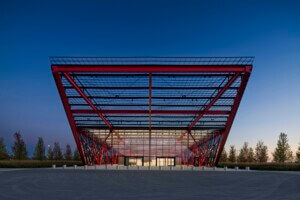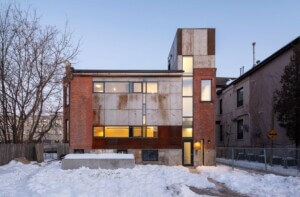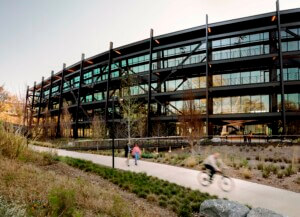An abstracted version of a street tree, a canopy of tessellated irregular polygons balances atop slim steel posts.
When Public: Architecture + Communication visited the site of the transit shelters the University of British Columbia had asked them to design, they found that something was missing. The main point of entry to the campus, University Boulevard is lined with trees—except where the bus shelters would go. “There was this language of gaps that we noticed,” said Public’s Christopher Sklar. The shelters themselves, they decided, should fill in the tree line. The designers were left with a question, articulated by Sklar: “How does it be a quiet piece but also something interesting and unusual that relates to its surroundings?”
Beginning with the image of a tree’s branch structure, Public placed a wood canopy defined by a repeating pattern atop slim steel posts. As for the pattern itself, the designers considered a range of options, from Moorish patterns to simple geometric shapes. The trouble with a geometric pattern, said Sklar, is that it is “often a static thing. We looked at triangles; they’re just triangles. Add a side, it’s just a square.” But if you add one more side, you have a pentagon. And that is where things get interesting. The tessellation of irregular pentagons is surprisingly complicated, on both a mathematical and an aesthetic level. “The thing that we liked about the repeating pentagon is that it creates something that is repetitive, but it’s also something that’s fluid and dynamic,” said Sklar. “It doesn’t feel like it’s repeating when you’re actually in it. It’s kind of a flowing structure above you.”
Public alternated between Rhino and Grasshopper, finding that it was easier to perfect a line drawing and plug it into Grasshopper than to allow Grasshopper to generate the tessellation. “I think it’s one of these things where it’s a new technology, people want to see what it can do, think it can help you generate forms,” said Sklar. “But it’s taking away the last thing we have left to us. We’re designers, we want to shape the thing.” The team built a full-scale model of two of the canopy’s cells to get a sense of their size, hoisting the cardboard shapes onto the ceiling pipes in their Vancouver studio.
- Fabricator Szolid, Structurlam, Bosmon Steelworks, Columbia Glazing Systems, Dancin Timber Works
- Designers Public: Architecture + Communication
- Location Vancouver, British Columbia
- Date of Completion September 2012
- Material Glulam, steel, concrete, glass
- Process Rhino, Grasshopper, modeling, CNC milling, welding, concrete casting
Structurlam fabricated the Glulam canopy on a Hundegger CNC machine. The steel supports were manually welded at Bosmon Steelworks. The shelter’s concrete benches were also fabricated by hand, at Szolyd. This was a surprise for Sklar, who had delivered a Rhino model of the bench design to the fabricators. But Szolyd said the design, which incorporates a series of fine edges as built-in skate-stops, would require as much work to prep the CNC machine as it would to build a mold manually—so they hired a carpenter to do just that. “Sometimes you do to all this work to make a digital model, and they’re like, ‘no, we’re just going to build it by hand,’” said Sklar. The shelters were assembled by Dan Georzen at Dancin Timber Works.
Besides the wood canopy itself, the most dynamic component of the transit shelter is its surround, built of bronze-tinted glass from Columbia Glazing Systems. The tint serves three purposes. First, it cuts down on UV exposure. Second, it will give the canopy a warm cast even as the wood weathers. Finally, it creates a subtle reveal for passers-by. “When you’re approaching the shelter you see it in front of you, you can’t see through the bronze-tinted thing,” said Sklar. “Then when you get under it, it reveals itself to you. As you approach, it reflects its surroundings from all sides; then you get underneath and: ‘oh wow, look at that.’”










